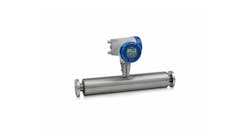Pelton was watching a spinning water turbine when the key holding its wheel onto its shaft slipped, causing it to become misaligned. Instead of the [water] jet hitting the cups in their middle, the slippage made it hit near the edge; rather than the water flow being stopped, it was now deflected into a half-circle, coming out again with reversed direction. Surprisingly, the turbine now moved faster. That was Pelton’s great discovery. In other turbines, the jet hit the middle of the cup and the splash of the impacting water wasted energy. Of course, there have been many refinements since Pelton’s first designs but, surprisingly, the basic concept remains the same. Let’s take a brief look at the current trend of traditional variable-area flowmeter replacement. After this, we can then compare the classic helical turbine design to the more modern turbine Pelton wheel sensor, which offers many benefits, especially for measuring very low flows. Trending Toward Rotameter Replacement Quite a number of years ago, designers of low-flow sensors recognized a need for very inexpensive products that could meet the needs of certain gas analyzer manufacturers and laboratories that were then using ball and tube flowmeters (known as variable-area flowmeters or rotameters) to determine flowrates. Although this segment of the industry was beginning to switch to computer-aided laboratory and analyzer automation, jumping from a $200 variable-area flowmeter to a $1,000 electronic flowmeter was not a viable option. The flowmeter industry responded to this need and small, inexpensive electronic flow sensors began to arrive on the market. Today, these sensors have been greatly improved and costs have continued to drop, narrowing the price gap between electronic sensors and traditional variable-area flowmeters.
The main advantages of the helical-blade design are its high accuracy, usually between (plus or minus) 0.5 to 1 percent of full-scale flow. In addition to its inherent high accuracy, the helical-blade turbine meter also has good repeatability, fast response (down to a few milliseconds), high pressure and temperature capabilities, and a generally compact and rugged construction. Some manufacturers have taken the helical design to the next level by incorporating advanced electronics that perform temperature compensation, signal conditioning, and linearization. This advanced technology allows the meter to quickly compensate for viscosity and density changes, an important consideration, especially for gas applications.
In order to convert the turbine wheel rotation into an electrical signal, an electro-optical system can be used. This system consists of an infrared diode beaming light through a glass window onto the turbine wheel. "Spokes" deposited on the turbine wheel alternately reflect and absorb the light. The reflected light is sensed by a photo-diode, and advanced electronics convert those pulses into a signal proportional to the flowrate. Such designs have proven successful for fluid flowrates between 13 ml/min and 10 L/min. Design Considerations By far, the greatest design problem of the Pelton wheel meter occurs when the wheel is required to rotate at very low gas flowrates. Why? Because the gas directed to the Pelton turbine wheel will have an impact force much lower in grams than the same flowrate of a liquid flowing through the same nozzle. Let’s look at the results of some early test data that indicates how the nozzle and turbine wheel should be designed in order to maximize accuracy and repeatability for both gas and liquid flows. Figure 2 shows actual test data that shows the impact force from the gas streaming from two different sizes of nozzles versus turbine wheel teeth spacing. To obtain the maximum of impact force, it becomes obvious that the blades receiving this impact force must be closely spaced. Test data confirms that blade or teeth spacing should not exceed 0.1 inch. Next, to obtain the lowest consistent repeatable flowrate using a Pelton turbine wheel, the diameter of the wheel becomes a consideration along with the type of bearings used to support the turbine wheel. As the turbine wheel diameter increases, so does the weight of the wheel. Further, the larger the diameter of the turbine wheel, the greater the need to dynamically balance the wheel to reduce both static torque at initial starting and, as flow increases thus causing the rotational speed of the wheel to increase, to minimize centrifugal force which could reduce the life of the turbine wheel bearings and shaft. Therefore, a small wheel is a desired design objective. The question then remains, how small should the turbine wheel be? To obtain the answer, the designer must first determine the choice of bearings and shaft. A good solution would be to examine prior designs to learn what others skilled in flow sensor design have done. It seems that for small sensor designs, the usage of sapphire jewel bearings combined with pointed tip sapphire shafts to support the turbine wheel have proven to be a good choice. Making the turbine wheel from a thin lightweight plastic is required to reduce the deadweight of the wheel on the bearing surface. Then the diameter of the turbine wheel must be considered. By actual experiments, a designer can determine the frictional torque required to be overcome before the gas through the nozzle will rotate the wheel, thus it is easier to determine the radial torque arm that the desired flowrate will need to induce wheel rotation. These experiments have been carried out and the results show that turbine wheels as small as a U.S. dime and about 0.03 inch thick are optimum. This is about the size of the turbine wheels found in the flow sensors shown in Figure 3a and 3b. For both gas and liquid flow sensors, the very light weight turbine wheels cause minimal wear on the sapphire shafts and bearings. In fact, in most liquids, these turbine wheels literally float in the liquid being measured. This phenomenon virtually eliminates shaft or bearing wear, allowing a very long service life. So, for extremely small Pelton wheel designs and to keep weight to the absolute minimum, photo-optical sensors have proven to be the best way to measure wheel rotation. To obtain an output signal, spokes or small holes are uniformly placed around the turbine wheel so the photo-optical signal can detect wheel rotation. Thus, the photo-optical beam is pulsed in direct proportion to the flowrate. Figure 4 schematically shows the arrangement used to obtain an output signal. Applications for Gas Flow Measurement Low-flow rate gas Pelton wheel flow sensors are finding a wide range of applications in both the OEM market and in a variety of laboratory applications. The flow sensor enjoys a higher accuracy level than ball and tube rotameters, primarily because they produce a signal proportional to the flowrate, allowing the user to monitor flowrate during periods when the activity is unattended. This is especially important in gas analyzer applications where the flow can be digitally displayed and the sensor signal used to automatically vary the span of the analyzer with changing flowrates. In certain situations when a gas analyzer is remotely located, diagnostic signals showing flowrate can be monitored. If a loss of critical flow occurs, the analyzer would know this and could either shut down the operation or notify a control station or both. In such situations, it is evident that slowly changing flowrates at or near atmospheric pressure are most suited for flowrate measurements by the micro turbine gas flow sensors. Where very rapid flowrate changes are to occur, then the gas turbine flow sensor may not be the best choice. However, in many laboratory and analyzer applications, the micro turbine gas flow sensor is typically the most cost-effective option. Applications for Liquid Flow Measurement Pelton liquid turbine flow sensors and flowmeters are exceptionally qualified to measure low flowrates of liquids with maximum viscosities of 10 centistokes. This low value of viscosity is necessary to ensure good linearity of the flow sensor. A number of companies will specify the usage of Pelton type turbine flow sensors in liquid applications at viscosities considerably higher than 10 centistokes, but in such cases external electronic linearization circuitry is typically employed and costs will increase if accuracy is to be preserved. However, for low-viscosity applications, such as water, Pelton turbine wheel liquid flow sensors are available with full-scale accuracies in the order of 1 percent or even 0.5 percent in flow ranges from 13 ml/min to 10 L/min. These liquid flow sensors are commercially available in a variety of materials, both of plastic and metal construction. This variety allows a wide range of liquids to be measured with a high level of precision. When combined with a display meter, the flow sensor is transformed into a flowmeter. Besides being a rugged workhorse in many laboratory applications, these flow products have seen applications in military and commercial scenarios. Low-flow measurements of diesel and gasoline fuel have been performed for a number of research applications. OEMs are using such sensors because of their low cost and high accuracy. It has been estimated that up to 50 percent of all Pelton turbine wheel sensors are sold to OEMs for custom applications. Micro Pelton design offers many benefits and advantages for a variety of low-flow liquid and gas applications. Modern Pelton designs offer low-cost, high-accuracy solutions for lab technicians, researchers, and OEM manufacturers. About the Authors Robert D. McMillan has masters’ degrees in Mechanical Engineering and Electrical Engineering from the University of Houston and Southern Methodist University, respectively. He is CEO of McMillan Company. Over the past 35 years, Mr. McMillan has been awarded five patents in the field of instrumentation for flow measurement and control, gas calibration equipment, and digital hydraulic actuation equipment. Under his direction, McMillan Company has developed a range of flow products, particularly in the area of low-flow measurement. Mr. McMillan can be reached at [email protected] 512 863-0231, ext. 12 . Corte Swearingen earned a degree in Physics from the University of Illinois in Urbana/Champaign and has conducted graduate studies in Electrodynamics at DePaul University in Chicago. Currently, Mr. Swearingen works for A. Daigger & Company, a provider of laboratory equipment and consumables. He has previous professional experience with Cole-Parmer Instrument Company and Brookhaven National Laboratory. Mr. Swearingen can be reached at [email protected] or 847 816-5060. For More Information: www.mcmflow.com; www.daigger.com References 1. McMillan Company, 2005 Catalog, Georgetown, TX, 2005. 2. A. Daigger & Company, 2005 Catalog, Vernon Hills, Il, 2005. 3. Swearingen, C., "Choosing the Best Flowmeter," Chemical Engineering, July 1999. 4. Swearingen, C., "Choose the Right Flowmeter," Chemical Engineering, Vol. 108, No. 1, 2001 5. Miller, R.W., Flow Measurement Engineering Handbook, 3 rd ed., McGraw-Hill, NY, 1996.

